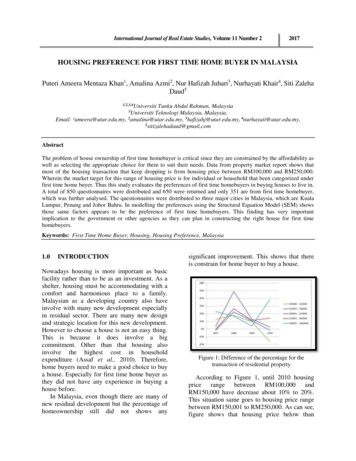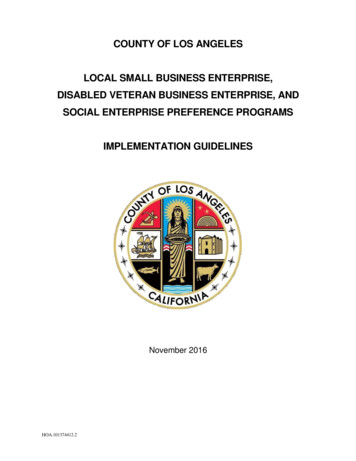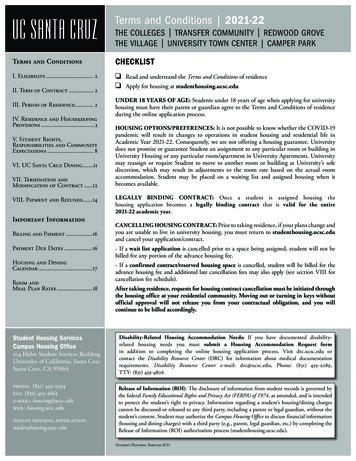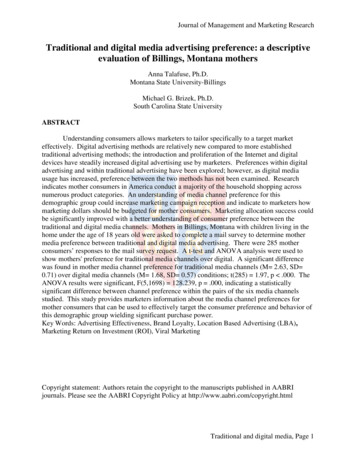
Transcription
International Journal of Real Estate Studies, Volume 11 Number 22017HOUSING PREFERENCE FOR FIRST TIME HOME BUYER IN MALAYSIAPuteri Ameera Mentaza Khan1, Amalina Azmi2, Nur Hafizah Juhari3, Nurhayati Khair4, Siti ZalehaDaud51,2,3,4Universiti Tunku Abdul Rahman, MalaysiaUniversiti Teknologi Malaysia, Malaysia.Email: ¹ameera@utar.edu.my, 2amalina@utar.edu.my, 3hafizahj@utar.edu.my, bstractThe problem of house ownership of first time homebuyer is critical since they are constrained by the affordability aswell as selecting the appropriate choice for them to suit their needs. Data from property market report shows thatmost of the housing transaction that keep dropping is from housing price between RM100,000 and RM250,000.Wherein the market target for this range of housing price is for individual or household that been categorized underfirst time home buyer. Thus this study evaluates the preferences of first time homebuyers in buying houses to live in.A total of 850 questionnaires were distributed and 650 were returned and only 351 are from first time homebuyer,which was further analysed. The questionnaires were distributed to three major cities in Malaysia, which are KualaLumpur, Penang and Johor Bahru. In modelling the preferences using the Structural Equation Model (SEM) showsthose same factors appears to be the preference of first time homebuyers. This finding has very importantimplication to the government or other agencies as they can plan in constructing the right house for first timehomebuyers.Keywords: First Time Home Buyer, Housing, Housing Preference, Malaysia1.0INTRODUCTIONNowadays housing is more important as basicfacility rather than to be as an investment. As ashelter, housing must be accommodating with acomfort and harmonious place to a family.Malaysian as a developing country also haveinvolve with many new development especiallyin residual sector. There are many new designand strategic location for this new development.However to choose a house is not an easy thing.This is because it does involve a bigcommitment. Other than that housing alsoinvolve the highest cost in householdexpenditure (Assaf et al., 2010). Therefore,home buyers need to make a good choice to buya house. Especially for first time home buyer asthey did not have any experience in buying ahouse before.In Malaysia, even though there are many ofnew residual development but the percentage ofhomeownership still did not shows anysignificant improvement. This shows that thereis constrain for home buyer to buy a house.Figure 1: Difference of the percentage for thetransaction of residential propertyAccording to Figure 1, until 2010 housingprice range between RM100,000 andRM150,000 have decrease about 10% to 20%.This situation same goes to housing price rangebetween RM150,001 to RM250,000. As can see,figure shows that housing price below than
Housing Preference forFirst Time Home Buyer in MalaysiaRM250,000 have shown a decreasing. Based onReal Estate and Housing Developer Association(REHDA), usually housing price below thanRM250,000 was aim to first time home buyer asthey was a group that need help to have theirown house. However, the ownership for thisgroup see too low. Why this happen?In order to understand about the eagerness offirst time home buyer for their future home, thispaper will elaborate more about housingpreference for first time home buyer. So theobjective of this paper is to analyse the housingpreference for first time home buyer.Hence, first time home buyer can becategorized as individual who is younggeneration have an age between 24 and 34 yearsold. This group represent individual who juststarted their job and did not owned any houseyet. Because of buying a house will involve a lotof procedure and financial source, so a lot ofthink need to be taken into consideration tomake this important decision. Especially for firsttime home buyer who mention before which isindividual who just started their working life.3.02.0FIRST TIME HOME BUYERFirst time home buyer can be defined as anindividual who did not own any house and haveintention to buy a house. Basically first timehome buyer was a young generation who goingto start their life such as new graduate.According to Housing Education and ResearchAssociation (HERA) (2006), the decision to buya house will be made when the household isincrease. Other that individual who is gettingmarried also will consider buying a house.Housing Education and Research Association(HERA) (2006), also adds that single householdwere preferable to rented rather than marriedcouple or family.Based on the researched by Duffy and Quail,(2005), first time home buyer is defined by agebetween 24 to 34 years old. This is similar to theresearched done by Glenworth MortgageInsurance. According to the organisation, firsttime home buyer is an individual age between25 and 31 years old Fierro et al. (2009).In Malaysia, first time home buyer can bedefined based on requirement mention bygovernment for First Home Scheme. Accordingto the requirement, first time home buyer mustbe age between 24 and 34 years old. However,Kuala Lumpur City Plan 2020 (2008) hasdefined first time home buyer is an individual inthe range of age between 20 and 40 years old.Usually this group have a small household orsingle. Other than that, this group also representthose who from a professional that just startedtheir first job. Most of them also were unstablein term of financial resource.International Journal of Real Estate Studies, Volume 11, Number 1, 2017FACTORSCONTRIBUTEHOUSINGPREFERENCEHOME BUYERTOFORHousing preference is important to makedecision in buying a house especially for firsthome. Even though housing was a basic needbut it involved lot of procedure and financialresource. Housing preference involve several offactor. This factor will influence in decisionmaking to buy a house. The decision making isdifferent for each individual. According toCostello (2009), there is probability that younggeneration who have small household willconsider buying a small house that located nearto his work place and vice versa. Other than that,income will probably influence the decisionmaking. The probability for those who havehigher income will choose to buy an expensivehouse rather than those who have middle andlower income.Housing Education and Research Association(HERA, 2006) have suggested a frameworkinvolving the effects on housing preference. Thisframework was focused on the effect to thelifestyle. Other than the lifestyle, housing normwas shown to give effect to the housingpreference as shown in Figure 2.Based on the framework, there are three mainfactors that affected housing preference which istype of household, social class and the value forhousing. According to Granbois (1971), thelarger size of household, they will prefer thebigger house. He also mentions that the lowerthe income or social class, the higher will be thecost of that need to be consider. This is becausehousing is the product that involves a lot ofmoney.Page 2
Housing Preference forFirst Time Home Buyer in Malaysiab) Social EnvironmentThese include status, safety, socialnetwork and lifestyle of the chosen area.c) Location and Public FacilitiesThe most important in making decisionfor home is the availability of facilitiessuch as shop and restaurant. Other thanthat are institution, sport area,playground, place that can be used tosocialize and can be symbolized culturealso need to be taken into consideration.Figure 2: Conceptual framework for influences onhousing choiceHowever, it was differing from theresearched done in Northern Mexico. Where inthese researched, there has about 12characteristic have been taken into considerationin buying a house Fierro et al. (2009). Thecharacteristic was include location, floor size,number of bedroom, number of bathroom,number of parking, number of floor, gated andguarded, security, green area, distance to school,distance to commercial area and accessibility,While according to Esinga and Hoekstra(2005), the most important in housing preferenceis the number of bedroom, type of house, age,income, total of household and expenditure.However the most important in buying a houseis the satisfaction of owning a house. Hence, thephysical and neighborhood factor is important tocreate harmonies (Levi and Lee, 2004).According to Andersen (2011), there have afew characteristics to ensure that the chosensurrounding and neighbourhood is suitable to beoccupied. These characteristic is divided to fourwhich are:a) Physical EnvironmentThese include physical characteristicand external condition of the building,entrance, physical disturbance such assoundandcontaminationandmaintenance standard. Other than thatdistance to green area should beconsidered.International Journal of Real Estate Studies, Volume 11, Number 1, 2017d) Location and TransportationLocation and transportation is definedhere as accessibility to the chosen houseor from the chosen house. These includedistance to workplace, distance tonearest town, distance to relatives’house and shopping complex.Other than factors mentioned, there is severalfactors have been identified. In NorthernMexico, there a researched have identified forthteen characteristic of the housing preference.This include location, floor area, number ofbathroom, number of bedroom, number ofparking, green area, furnishes, gated andguarded, distance to school, distance tocommercial area and accessibility factor.However, structure characteristic is look moreimportant rather than location. This is differentwith the single buyer where they more considerinto the number of bedroom and floor area.Due to many factors that influence thedecision of home buyer to buy a house, Lee(1992), has come out with a one theory. Thetheory is about how to make decision for thefamily who have intention to buy a house as inFigure 3.Finally, from the literature all the factors thatcontribute to the housing preference among firsttime home buyer have been identified. Thisresearch has come out with one concept as inFigure 4.Page 3
Housing Preference forFirst Time Home Buyer in MalaysiaFigure 3: Housing decision making theory for homebuyerbeing used because of the precision of the PLSconcept which is the data that cannot be see buthave relationship between each factors (Bagoziand Philips, 1982).The purpose of using PLS is to develop thestructural equation model (SEM) of housingpreference for first time home buyer inMalaysia. SEM enables simultaneous modellingof the relationship between independent anddependent variables being constructed (Cassel etal., 1999). According to Hulland (1999), theindicators in the developing modelling can beeither positive, negative or correlated (zero).This analysis also allows researchers tobuild unobservable variables measured usingindicators. According to Bagozi and Philips(1982), SEM can be understood through threedifferent concepts which are:Table 1: Structural Equation Model (SEM) ConceptTheory conceptEmpirical conceptFigure 4. Concept of housing preference for first timehome buyer4.0METHODOLOGY OF RESEARCHAbout 800 questionnaires have been distributedaround Klang Valley, Johor Bharu and Penang.However, only 650 was return and on 351respondents is identify as first time home buyer.Limitation of the research was based on threechosen state in Malaysia which is Johor Bahru,Penang and Kuala Lumpur. These three stateshave become as focal point in Malaysia andhave attracted many of young generationbecause of the job opportunity offer.Once the entire questionnaire beingcollected, the data being analyze used partiallease square (PLS) analysis. This analysis haveInternational Journal of Real Estate Studies, Volume 11, Number 1, 2017Concept derivedAbstract, attributes orcharacteristics of a socialentity unit invisibleRefer to property orrelationship in which thepresence or absence incertain circumstances maybebetweensubjectspredetermined, in certaincircumstancesthroughconstant observation.Invisible (like the theoryconcept) but should betied directly to theempirical conceptAs this researched involves data thatcannot be observed as well as a great diversity,SEM has being choose to analyse the datagather. In the end, a model of housingpreference for first time home buyer beingdevelops.Page 4
Housing Preference forFirst Time Home Buyer in Malaysia5.0HOUSINGPREFERENCEFORFIRST TIME HOME BUYER INMALAYSIAThe composite reliability for the variance showsthat all the factors are reliable accepts fordemographic factor. According to Chin (1998),the reliable variance must be at least 0.70.Table 2: Constructed Reliability in the eNeighbourhoodeconomicNo. of 3460.7168220.938242In order to evaluate the discriminant validity,the average of variance is extracted for eachvariance (Fornell and Bookstein, 1982) Otherthan that, the relationship between the factorsshould be lower than square roots of the averagevariance extracted. The value of the averagevariance extracted (AVE) must be more than 0.5to shows the discriminant validity (Bagozi andPhilips, 1982; Fornell and Bookstein, 1982).Based on the Table 3, there is onlydemographic and financial factors that show theaverage value of the variance lower than 0.50.This explain that the other factors such aseconomic, location, neighbourhood and structureis more important in order to determine thehousing preference for first time home buyer.Table 3: The Average Variance Extracted 67660.5562780.531786After analyzing the measurement model, thenext step in the analysis of PLS is to build astructure model using inner model. Priorexamination of the weighting between variableswas performed to identify the importance ofusing T-statistic.International Journal of Real Estate Studies, Volume 11, Number 1, 2017Table 4: Path Coefficients (ᵝ) and Significance for thestructural modelPredictorPredictedconstructconstructDemo - housing ownershipEconomy - housingownershipFinancial - ownershipLocation - housingownershipNeighbourhood- housingownersipStructure - housingownershipPathCoefficients 1.880133Table 4 shows the relationships between thefactors of housing preference and housingownership. Based on the t value, shows that onlyeconomic, financial and neighbourhood have arelationship with housing ownership. Bothfactors have shown a significant t value which ist 1.96* (p 0.05); t 2.58** (p 0.01).6.0CONCLUSIONFinally, this paper has effectively elaborated thehousing preference for first time home buyer.According to the data analysis, result shows thatin Malaysia, first time home buyer are preferablethe economic, neighbourhood, structure andlocation factors in order to make a decision tobuy a new house.In the future research, every each factor thatcontributes to the housing preference can beelaborate and analyses more deeply. Other thanthat the total respondents can be expands toother countries so that the housing preferencebetween in urban and sub urban can bedifferentiate.ACKNOWLEDGEMENTThe authors would like to express their sincereappreciation to Universiti Tunku Abdul Rahmanand all party that involved in this research.Page 5
Housing Preference forFirst Time Home Buyer in MalaysiaREFERENCEAndersen, H. S. (2011). Explaining Preferencesfor Home Surrounding and Locations.Urbani Izziv, 22(1), pp. 100-114.Assaf, S. A., Bubshaitr, A. A., & AlMuwasheer, F. (2010). Factors affectingaffordable housing cost in Saudi Arabia.International Journal of Housing Marketsand Analysis, 3(4), pp. 290–307.Bagozzi, R. P. & Philipps, L. W. (1982).Representing and Testing rative Science Quarterly, 27, pp.459-489.Cassel, C. M., Hackl, P. & Westlund, A. H.(1999). Robustness of Partial Least SquaresMethod for Estimating Latent VariableQuality Structure. Journal of AppliedStatistic, 26, pp. 435-446.Costello, L. (2009). Urban–Rural Migration:housing availability and affordability.Australian Geographer, 40(2), pp. 219–233.Chin, W. W. (1998). Issue and Opinion onStructural Equation Modelling. MISQuarterly, 22(1), pp. 8-16.Duffy, D. & Quail A. (2005). First Time Buyersin the Irish Housing Market: A Survey ofPermanent tsb First Time Buyers. TheEconomic and Social Research Institute,Dublin.Elsinga, M. & Hoekstra, J. (2005).Homeownership and Housing Satisfaction.Journal of Housing and the BuiltEnvironment, 20, pp. 401-424.Fierro, K. P., Fullerton Jr., T. M. & DonjuanCallejo, K. E. (2009). Housing AttributePreference in a Northern MexicoMetropolitan. Economy, 37, pp. 159-172.Fornell, C. & Bookstein, F. L. (1982). TwoStructural Equation Models: LISREL andPLS Applied to Consumer Exit-VoiceTheory. Journal of Marketing Research, 19,pp. 440-452.Granbois, D. H. (1971). A Multilevel Approachto Family Role Structure Research, inGardner, D.M.: Advance in ConsumerResearch, Association for ConsumerResearch; College Park, pp. 99-107.International Journal of Real Estate Studies, Volume 11, Number 1, 2017Hulland, J. (1999). Use of Partial Least Square(PLS) in Strategic Management Research:A Review of Four Recent Studies. StrategicManagement Journal, 20, pp. 195-204.Kuala Lumpur City Plan 2020. (2008). KualaLumpur City hall.Laporan Pasaran Harta 2000, Jabatan Penilaiandan Pengurusan Harta Tanah, 2000.Laporan Pasaran Harta 2001, Jabatan Penilaiandan Pengurusan Harta Tanah, 2001.Laporan Pasaran Harta 2002, Jabatan Penilaiandan Pengurusan Harta Tanah, 2002.Laporan Pasaran Harta 2003, Jabatan Penilaiandan Pengurusan Harta Tanah, 2003.Laporan Pasaran Harta 2004, Jabatan Penilaiandan Pengurusan Harta Tanah, 2004.Laporan Pasaran Harta 2005, Jabatan Penilaiandan Pengurusan Harta Tanah, 2005.Laporan Pasaran Harta 2006, Jabatan Penilaiandan Pengurusan Harta Tanah, 2006.Laporan Pasaran Harta 2007, Jabatan Penilaiandan Pengurusan Harta Tanah, 2007.Laporan Pasaran Harta 2008, Jabatan Penilaiandan Pengurusan Harta Tanah, 2008.Laporan Pasaran Harta 2009, Jabatan Penilaiandan Pengurusan Harta Tanah, 2009Laporan Pasaran Harta 2010, Jabatan Penilaiandan Pengurusan Harta Tanah, 2010.Laporan Status Pasaran Harta Q4 2010, JabatanPenilaian dan Pengurusan Harta Tanah,2010.Levy, D. S. & Lee, C. K. C. (2004). TheInfluence of Family Members on HousingPurchase Decisions. Journal of PropertyInvestment and Finance, 22(4), pp. 320338.Lee, C. K. C. (1992). A model of Family BuyerBehaviour New Zealand. Journal ofBusiness, 14, pp. 50-60.Housing Education and Research Association(HERA) (2006). Introduction to Housing,Pearson Education, New Jersey.Page 6
(2005), first time home buyer is defined by age between 24 to 34 years old. This is similar to the researched done by Glenworth Mortgage Insurance. According to the organisation, first time home buyer is an individual age between 25 and 31 years old Fierro et al. (2009). In Malaysia, first time home buyer can be











